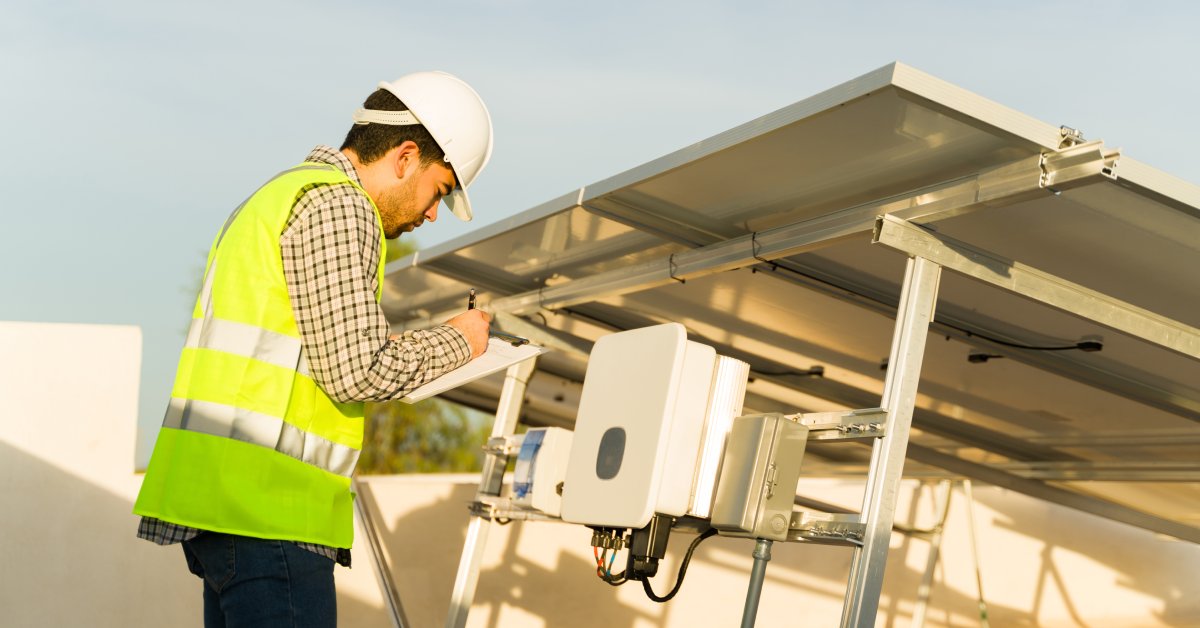There are several types of solar inverters—string, microinverter, hybrid, off-grid, and grid-tie—and choosing the right one is key to getting the most out of your solar panels. That’s because it does more than just convert DC to AC power. A solar inverter is the heart of your solar system, ensuring every bit of sunlight is turned into usable electricity.
In this guide, we’ll explain how each type works, what makes them different, and how to choose the best solar inverter for your solar panels, budget, and installation type.
What Is a Solar Inverter and How Does It Work?
A solar inverter is the critical interface between solar panel output and household electrical systems. Panels generate direct current (DC) electricity, while residential and commercial appliances operate on alternating current (AC). The inverter performs the essential conversion process, transforming DC power from the panels into AC electricity compatible with standard electrical devices and grid infrastructure.
However, modern solar inverters extend beyond basic power conversion. These smart devices optimize energy production, monitor system performance, and even communicate with the grid. They ensure that the power flowing through your home is clean, stable, and efficient. In fact, the quality and type of your inverter can directly impact how much usable electricity you get from your solar panels, which is why this decision matters more than most people realize.
Whether you're planning an off-grid solar power system or a grid-tied setup, your inverter serves as the central nervous system of your solar installation. It manages power flow, protects against electrical issues, and maximizes your return on investment. Without it, you're just generating electricity with nowhere for it to go.
6 Different Types of Solar Inverters
Let's break down the six main types of solar inverters, so you can decide which one to include in your solar system.
#1. String Inverters
String inverters have been around the longest, and for good reason. They're reliable, cost-effective, and get the job done. In this setup, your solar panels are connected in series, and all that power feeds into one central inverter, usually mounted on the side of your house or in your garage.
These inverters work best when the position of your panels is such that all individual units get similar amounts of sunlight throughout the day. If you've got a simple roof with no shading issues and want to keep installation costs down, a string inverter is probably the best choice. Also, they're the most budget-friendly option upfront, and replacement parts are easy to find if something goes wrong.
Let’s see a breakdown of pros and cons of string inverters:
|
Pros |
Cons |
|
|
#2. Microinverters

Compared to a string inverter, a microinverter is attached to each solar panel. This means every panel operates independently, so if one gets shaded by a tree or covered by leaves, it doesn't drag down the performance of the entire system.
Microinverters have become a go-to solution for homeowners with shading issues or complex roof layouts. They're also great if you plan to expand your system later, since you can add panels one at a time without worrying about string configurations. Plus, they typically come with longer warranties, often matching the lifespan of your panels.
However, like any other device, microinverters have their advantages and disadvantages:
|
Pros |
Cons |
|
|
#3. Hybrid Inverters

As an all-in-one package, hybrid inverters can handle power from your panels, manage battery storage, and work with the grid. If you're thinking about adding batteries to your solar setup, a hybrid inverter gives you that flexibility without needing to overhaul your entire system later.
These inverters are perfect if you want energy independence but aren't ready to go completely off-grid. They let you store excess solar energy during the day and use it at night or during power outages.
Now that we’ve explained what hybrid inverters do, let’s see their pros and cons:
|
Pros |
Cons |
|
|
#4. Power Optimizers
Power optimizers are the middle ground between string inverters and microinverters. Like microinverters, they're installed on each panel to optimize output. However, instead of converting DC to AC on the roof, they "condition" the power and send it to a central string inverter for conversion.
This setup gives you some of the benefits of microinverters (panel-level monitoring, better performance in shade) at a lower cost. It's a popular compromise for homeowners who want panel-level optimization without the higher price tag of a full microinverter system.
Here’s a complete breakdown of advantages and shortcomings of power optimizers:
|
Pros |
Cons |
|
|
#5. Grid-Tie Inverters
Grid-tie inverters connect your solar system directly to the utility grid. When your panels generate more electricity than you're using, the excess flows back to the grid, and you get credit through net metering. However, on cloudy days, you pull power from the grid like normal.
These inverters are the most common choice for homes because they don't require battery storage, which keeps costs down. They also automatically shut off during power outages (to protect utility workers), so you won't have backup power during blackouts unless you pair them with batteries.
Let’s see the pros and cons of grid-tie inverters:
|
Pros |
Cons |
|
|
#6. Off-Grid Inverters
Off-grid inverters are built for complete energy independence. These inverters work exclusively with battery systems and have no connection to the utility grid whatsoever. They're the go-to choice for remote locations, tiny homes, RVs, or anyone who wants to cut ties with the power company entirely.
However, off-grid inverters need to be reliable because there's no grid to fall back on. Therefore, this type of setup requires careful system planning and design to ensure your energy needs year-round—especially during winter when sunlight hours drop.
Here are a few advantages and disadvantages of this kind of setup:
|
Pros |
Cons |
|
|
How to Choose the Right Inverter for Your Needs: 5 Factors to Consider

When choosing an inverter, you need to consider several factors, and making the right decision can save you money and future work.
#1. System Size
The size of your solar installation determines which inverter makes sense. For smaller residential systems, let’s say, under 5 kW, a single string inverter might be adequate—and the most budget-friendly option. This means a straightforward installation and fewer system components to worry about.
However, with a bigger system—maybe a 10kW or 11kW system—you might benefit from multiple string inverters, a combination of power optimizers, or even a full microinverter setup. The key is matching your inverter capacity to your panel output because oversizing or undersizing can hurt your system efficiency and your wallet.
#2. Battery Storage
If batteries are part of your solar installation plan (or might be someday), to avoid any mistakes, you want either a hybrid inverter or an off-grid inverter that can manage both solar input and battery charging.
If you don’t have battery storage, a standard grid-tie inverter will work just fine, and it'll save you money upfront. However, if you live in an area with frequent power outages or bad weather, adding battery storage—and the right inverter to support it—can provide real peace of mind.
#3. Energy Goals
If you just want to reduce your utility costs and don't care much about outages, a simple grid-tie inverter is the most suitable choice. On the other hand, if energy independence is the goal—maybe you want to go completely off-grid—then you'll need an inverter that works with batteries and doesn't rely on the grid at all.
If you're somewhere in between, aiming for maximum savings with some backup capability, a hybrid inverter gives you the best of both worlds.
#4. Budget
Solar is an investment, and while it pays off over time, the upfront costs can be steep. String inverters are the most affordable, typically ranging from a few hundred to a couple thousand dollars depending on system size. Microinverters and hybrid systems cost more initially but can offer better long-term performance and flexibility.
However, don't just look at the price itself. Factor in warranties, expected lifespan, and potential energy savings. A cheaper inverter that needs replacement in 10 years might end up costing more than a pricier option with a 25-year warranty.
#5. Roof Characteristics and Shading
If you plan a rooftop installation, it affects the selection of your inverter. With a south-facing roof with no shade, a string inverter will work beautifully. However, if you've got dormers, chimneys, multiple roof planes, or trees casting shadows during parts of the day, you'll want panel-level optimization.
Microinverters or power optimizers are a good option in these scenarios because they let each panel work independently. One shaded panel won't drag down the whole system. This can mean a significant difference in energy production—sometimes 10-20% more power over the system's lifetime.
Explore High-Quality Solar Inverters at Portable Sun
At Portable Sun, we offer a wide range of inverters to match every budget and system design. Whether you need a reliable string inverter for a straightforward rooftop install, a cutting-edge hybrid system with a battery backup, or microinverters for a complex roof layout, we've got you covered with top brands and expert support to guide your choice.
Final Thoughts
Choosing the right solar inverter is a decision that impacts your overall system performance, efficiency, and long-term value. The "best" inverter isn't universal; it's the one that aligns with your unique situation, whether that's budget constraints, shading issues, energy independence goals, or future expansion plans.
String inverters work great for simple setups. Microinverters excel in complex or shaded environments. Hybrid inverters offer flexibility if you want battery storage as well. On the other hand, off-grid inverters deliver total energy independence. Take your time, assess your needs honestly, and don't hesitate to reach out to professionals for advice.
Types of Solar Inverters FAQ
#1. What is the most common type of inverter?
String inverters remain the most common type for residential solar installations due to their lower cost and proven reliability. They're well-suited for homes with simple roof layouts and minimal shading.
#2. Can I mix inverter types in one system?
Generally, no. Mixing inverter types within a single solar system isn't recommended and often isn't technically feasible. Each inverter type is designed to work within specific system architectures, and combining them can lead to compatibility issues, reduced inverter efficiency, and complications with monitoring and warranties.
#3. What maintenance do inverters require?
Inverters require minimal maintenance—mostly just periodic inspections to ensure they're working properly and keeping firmware updated. String inverters may need more attention since they're a single point of failure, while microinverters are often "set it and forget it." Check for error messages regularly and keep the area around your inverter clean and well-ventilated.
#4. Do inverters affect solar panel efficiency?
Absolutely. Inverters can impact your overall system efficiency as the type of inverter affects how well your panels perform under various conditions. Microinverters and power optimizers can boost total system output by 10-20% in shaded or complex installations compared to string inverters.
#5. What type of inverter is most efficient?
Microinverters and hybrid inverters tend to have the highest efficiency ratings, often exceeding 97%. However, real-world efficiency depends on your specific installation conditions. A well-matched string inverter on an ideal roof might outperform microinverters in less-than-ideal conditions.
#6. How long do inverters last?
Most solar inverters have an average lifespan of around 15 years. Since a typical solar power system lasts 25 to 30 years, the inverter usually needs to be replaced once during the system’s lifetime to maintain optimal performance and energy conversion efficiency.

